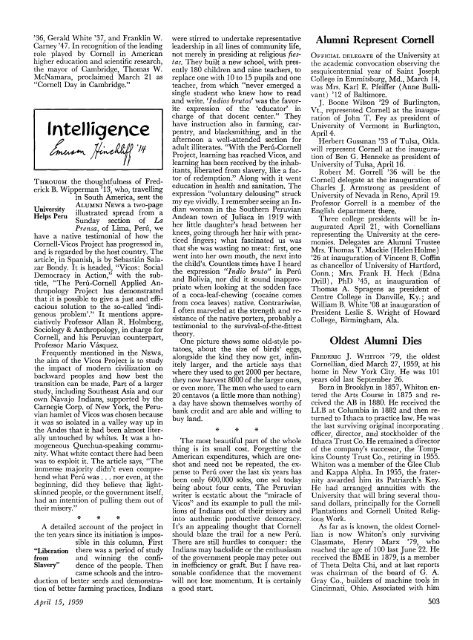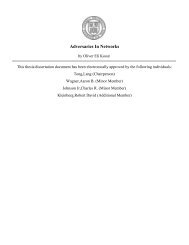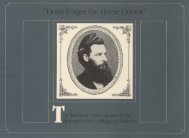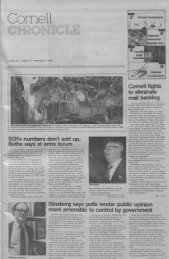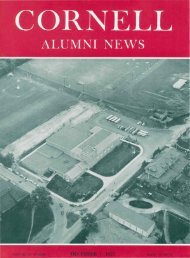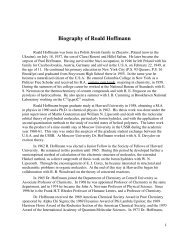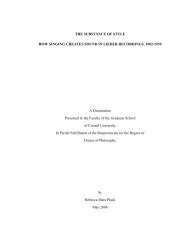ALUMNI NEWS - eCommons@Cornell - Cornell University
ALUMNI NEWS - eCommons@Cornell - Cornell University
ALUMNI NEWS - eCommons@Cornell - Cornell University
Create successful ePaper yourself
Turn your PDF publications into a flip-book with our unique Google optimized e-Paper software.
5 36 5<br />
Gerald White '37, and Franklin W.<br />
Carney '47. In recognition of the leading<br />
role played by <strong>Cornell</strong> in American<br />
higher education and scientific research,<br />
the mayor of Cambridge, Thomas W.<br />
McNamara, proclaimed March 21 as<br />
"<strong>Cornell</strong> Day in Cambridge."<br />
Intelligence<br />
THROUGH the thoughtfulness of Frederick<br />
B. Wipperman Ί3 5<br />
who, travelling<br />
in South America, sent the<br />
τ τ<br />
. . <strong>ALUMNI</strong> <strong>NEWS</strong> a two-page<br />
HeίpsTeJu illustrated s P r e a d from a<br />
Sunday section of La<br />
Prensa, of Lima, Peru, we<br />
have a native testimonial of how the<br />
<strong>Cornell</strong>-Vicos Project has progressed in,<br />
and is regarded by the host country. The<br />
article, in Spanish, is by Sebastian Salazar<br />
Bondy. It is headed, "Vicos: Social<br />
Democracy in Action," with the subtitle,<br />
"The Peru-<strong>Cornell</strong> Applied Anthropology<br />
Project has demonstrated<br />
that it is possible to give a just and efficacious<br />
solution to the so-called 'indigenous<br />
problem 5 ." It mentions appreciatively<br />
Professor Allan R. Holmberg,<br />
Sociology & Anthropology, in charge for<br />
<strong>Cornell</strong>, and his Peruvian counterpart,<br />
Professor Mario Vasquez.<br />
Frequently mentioned in the <strong>NEWS</strong>,<br />
the aim of the Vicos Project is to study<br />
the impact of modern civilization on<br />
backward peoples and how best the<br />
transition can be made. Part of a larger<br />
study, including Southeast Asia and our<br />
own Navajo Indians, supported by the<br />
Carnegie Corp. of New York, the Peruvian<br />
hamlet of Vicos was chosen because<br />
it was so isolated in a valley way up in<br />
the Andes that it had been almost literally<br />
untouched by whites. It was a homogeneous<br />
Quechua-speaking community.<br />
What white contact there had been<br />
was to exploit it. The article says, "The<br />
immense majority didn't even comprehend<br />
what Peru was . . . nor even, at the<br />
beginning, did they believe that lightskinned<br />
people, or the government itself,<br />
had an intention of pulling them out of<br />
their misery."<br />
# # #<br />
A detailed account of the project in<br />
the ten years since its initiation is impos-<br />
"Liberation<br />
from<br />
Slavery"<br />
sible in this column. First<br />
there was a period of study<br />
and winning the confidence<br />
of the people. Then<br />
came schools and the introduction<br />
of better seeds and demonstration<br />
of better farming practices. Indians<br />
April 15, 1959<br />
were stirred to undertake representative<br />
leadership in all lines of community life,<br />
not merely in presiding at religious fiestas.<br />
They built a new school, with presently<br />
180 children and nine teachers, to<br />
replace one with 10 to 15 pupils and one<br />
teacher, from which "never emerged a<br />
single student who knew how to read<br />
and write. Ίndios brutos 3 was the favorite<br />
expression of the 'educator' in<br />
charge of that docent center." They<br />
have instruction also in farming, carpentry,<br />
and blacksmithing, and in the<br />
afternoon a well-attended section for<br />
adujt illiterates. "With the Peru-<strong>Cornell</strong><br />
Project, learning has reached Vicos, and<br />
learning has been received by the inhabitants,<br />
liberated from slavery, like a factor<br />
of redemption." Along with it went<br />
education in health and sanitation. The<br />
expression "voluntary delousing" struck<br />
my eye vividly. I remember seeing an Indian<br />
woman in the Southern Peruvian<br />
Andean town of Juliaca in 1919 with<br />
her little daughter's head between her<br />
knees, going through her hair with practiced<br />
ringers; what fascinated us was<br />
that she was wasting no meat: first, one<br />
went into her own mouth, the next into<br />
the child's. Countless times have I heard<br />
the expression "Indio bruto" in Peru<br />
and Bolivia, nor did it sound inappropriate<br />
when looking at the sodden face<br />
of a coca-leaf-chewing (cocaine comes<br />
from coca leaves) native. Contrariwise,<br />
I often marveled at the strength and resistance<br />
of the native porters, probably a<br />
testimonial to the survival-of-the-fittest<br />
theory.<br />
One picture shows some old-style potatoes,<br />
about the size of birds' eggs,<br />
alongside the kind they now get, infinitely<br />
larger, and the article says that<br />
where they used to get 2000 per hectare,<br />
they now harvest 8000 of the larger ones,<br />
or even more. The men who used to earn<br />
20 centavos (a little more than nothing)<br />
a day have shown themselves worthy of<br />
bank credit and are able and willing to<br />
buy land.<br />
The most beautiful part of the whole<br />
thing is its small cost. Forgetting the<br />
American expenditures, which are oneshot<br />
and need not be repeated, the expense<br />
to Peru over the last six years has<br />
been only 600,000 soles, one sol today<br />
being about four cents. The Peruvian<br />
writer is ecstatic about the "miracle of<br />
Vicos" and its example to pull the millions<br />
of Indians out of their misery and<br />
into authentic productive democracy.<br />
It's an appealing thought that <strong>Cornell</strong><br />
should blaze the trail for a new Peru.<br />
There are still hurdles to conquer: the<br />
Indians may backslide or the enthusiasm<br />
of the government people may peter out<br />
in inefficiency or graft. But I have reasonable<br />
confidence that the movement<br />
will not lose momentum. It is certainly<br />
a good start.<br />
Alumni Represent <strong>Cornell</strong><br />
OFFICIAL DELEGATE of the <strong>University</strong> at<br />
the academic convocation observing the<br />
sesquicentennial year of Saint Joseph<br />
College in Emmitsburg, Md., March 14,<br />
was Mrs. Karl E. Pfeiffer (Anne Bullivant)<br />
'12 of Baltimore.<br />
J. Boone Wilson '29 of Burlington,<br />
Vt, represented <strong>Cornell</strong> at the inauguration<br />
of John T. Fey as president of<br />
<strong>University</strong> of Vermont in Turlington,<br />
April 4.<br />
Herbert Gussman '33 of Tulsa, Okla.<br />
will represent <strong>Cornell</strong> at the inauguration<br />
of Ben G. Henneke as president of<br />
<strong>University</strong> of Tulsa, April 16.<br />
Robert M. Gorrell '36 will be the<br />
<strong>Cornell</strong> delegate at the inauguration of<br />
Charles J. Armstrong as president of<br />
<strong>University</strong> of Nevada in Reno, April 19.<br />
Professor Gorrell is a member of the<br />
English department there.<br />
Three college presidents will be inaugurated<br />
April 21, with <strong>Cornell</strong>ians<br />
representing the <strong>University</strong> at the ceremonies.<br />
Delegates are Alumni Trustee<br />
Mrs. Thomas T. Mackie (HelenHolme)<br />
'26 at inauguration of Vincent B. Coffin<br />
as chancellor of <strong>University</strong> of Hartford,<br />
Conn.; Mrs. Frank H. Heck (Edna<br />
Drill), PhD '45, at inauguration of<br />
Thomas A. Spragens as president of<br />
Centre College in Danville, Ky. and<br />
William B. White '08 at inauguration of<br />
President Leslie S. Wright of Howard<br />
College, Birmingham, Ala.<br />
Oldest Alumni Dies<br />
FREDERIC J. WHITON '79, the oldest<br />
<strong>Cornell</strong>ian, died March 27, 1959, at his<br />
home in New York City. He was 101<br />
years old last September 26.<br />
Born in Brooklyn in 1857, Whiton entered<br />
the Arts Course in 1875 and received<br />
the AB in 1880. He received the<br />
LLB at Columbia in 1882 and then returned<br />
to Ithaca to practice law. He was<br />
the last surviving original incorporating.<br />
officer, director, and stockholder of the<br />
Ithaca Trust Co. He remained a director<br />
of the company's successor, the Tompkins<br />
County Trust Co., retiring in 1955.<br />
Whiton was a member of the Glee Club<br />
and Kappa Alpha. In 1955, the fraternity<br />
awarded him its Patriarch's Key.<br />
He had arranged annuities with the<br />
<strong>University</strong> that will bring several thousand<br />
dollars, principally for the <strong>Cornell</strong><br />
Plantations and <strong>Cornell</strong> United Religious<br />
Work.<br />
As far as is known, the oldest <strong>Cornell</strong>ian<br />
is now Whiton's only surviving<br />
Classmate, Henry Marx '79, who<br />
reached the age of 100 last June 22. He<br />
received the BME in 1879, is a member<br />
of Theta Delta Chi, and at last reports<br />
was chairman of the board of G. A.<br />
Gray Co., builders of machine tools in<br />
Cincinnati, Ohio. Associated with him<br />
503


